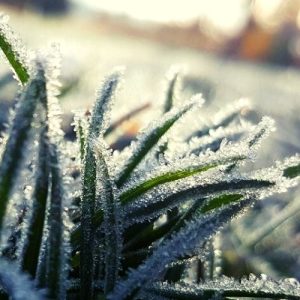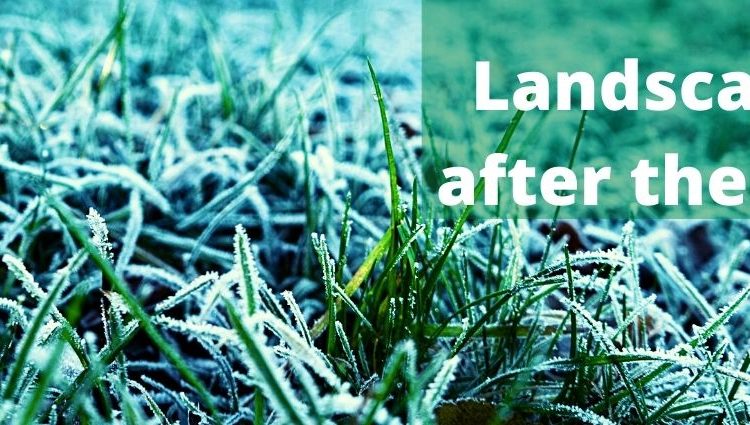Frost and cold can make warm weather plants look dead, wilted, and ugly. The urge to clip them down or pull them out should be restrained. The plants are at their most vulnerable and clipping will make it worse. Non-wood plants can be trimmed slightly if the frost is felt to be gone. Use caution. The top of most plants felt the wrath of the freeze and looks wilted or dead. Without extra water or fertilizer at this point, nip off the top dead looking parts and leave the healthy bottom to strengthen.
Southern and warm weather plants may take a few weeks to show the full extent of damage or repair after a freeze. Lawns that appear dead or nonexistent will reappear in time on their own. Most plants are resilient. Any green shoots and green stems are a sign of hope.
 Lawns After a Freeze
Lawns After a Freeze
Although the bad appears as dead as the good, weeds and crab grass will appear. Let the brown grass be. It will die off and let green grass lawn cover it with time. Leaves on the ground will provide a warm covering so they too can be left for a while despite how unattractive the place seems. Mowing isn’t recommended since it is a form of clipping while the plant is vulnerable. Landscape may be covered by beds of dead leaves or growth keeping it warm.
Tropical Plants After a Freeze
The brown leaves mean damage. The plant will continue to either demise or renew. Covering it or bringing it to a new location won’t necessarily stop the process initiated with the freeze. Fertilizing too should wait. Indoor treatment may encourage new growth but won’t turn brown leaves green. Bougainvilleas may not survive. Frangipani or Plumeria are wood plants native to warm tropical places and may have a rough time coming back after a frost. Crape Myrtle trees will most likely come back. Flowering perennials may have roots that survive. Give them time without pruning.
Citrus and other Warm Climate Trees After a Hard Winter
 Larger trees may only have peripheral branches browned and wilted. The fruit may be smaller and may have frozen on the tree. (Think oranges and grapefruits placed in the freezer.) There is no harm in testing by cutting a piece open and seeing its appearance. Frozen fruit is mealy and membranous. Fig trees may or may not survive depending on size. Lime and lemon trees are delicate. Avocado trees may survive but not produce fruit for a season. Mangos are cold sensitive and probably won’t make it, ditto Papaya trees.
Larger trees may only have peripheral branches browned and wilted. The fruit may be smaller and may have frozen on the tree. (Think oranges and grapefruits placed in the freezer.) There is no harm in testing by cutting a piece open and seeing its appearance. Frozen fruit is mealy and membranous. Fig trees may or may not survive depending on size. Lime and lemon trees are delicate. Avocado trees may survive but not produce fruit for a season. Mangos are cold sensitive and probably won’t make it, ditto Papaya trees.
Hibiscus can go dormant in cold weather but are a tropical plant. Cold and wet cold are anathema to this plant. The leaves wither, brown, and die. Recovery can be lengthy if at all. Blooming may take an entire season to recur.
Palm Trees Suffer in the Extreme Cold
Palms can take months to recover. Brown leaves can be trimmed. The base of the palm may develop fungus if saturated by cold wet atmosphere. Palms are susceptible to diseases when exposed to extreme cold weather. There are fungicides for this purpose. Fertilizing isn’t needed until spring
Roots may be alive and the stem can be scraped to se if it’s got green tissue. Sadly not all plants survive a freeze or a cold unusual winter. The wait and see attitude is the best option before prematurely uprooting or removing living plants.



Comments are closed, but trackbacks and pingbacks are open.